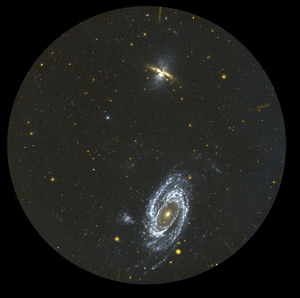Astronomers are like forensic investigators. We have all this data taken from the scene of some sort of event, and have to piece together what happened. But those folks on CSI have it easy: they get to actually walk around the scene, poke and prod it, examine various stains, and even take physical evidence back to the lab. Astronomers are stuck standing a quintillion kilometers away, and we only get to see things at one angle.
But oh, what an angle. If it pleases the court, I’d like to enter this evidence for your consideration:
That’s my kind of evidence (click to embiggen). It’s an image of the lovely grand-design spiral galaxy M81, one of the nearest major galaxies to our own. At about 12 million light years away it’s bright enough to be seen in binoculars (and in fact some extremely keen-eyed observers have been able to see it with their unaided eyes). That means it’s close enough to study in detail… and what detail! This image is from the monster Subaru telescope, an 8.2 meter (27 foot!) goliath at the peak of the Mauna Kea volcano in Hawaii. The purpose of the image was to examine the galaxy’s halo, the vast region of stars surrounding the main body of the galaxy itself. The current thinking is that big galaxies like M81 and our own Milky Way form when smaller galaxies collide. We have a lot of evidence for this in our galaxy – we’re in the process of eating and digesting several small galaxies even as you read this – but the exact process is unclear.
That’s why we look at galaxy halos. When galaxies collide, a lot of stars get kicked into higher orbits, propelling them out of the main body of the wreck and into the halo. If this were a crime procedural drama, you could think of these stars as blood spatters seen on walls, pointing back silently to the method of the crime, giving the investigators clues on how they got there.
The thing is, the halo of M81 is weird. You might think it would look a lot like the Milky Way’s halo: the masses of the two galaxies are roughly the same, and we expect they formed the same way. But the population of stars surrounding M81 is different! For one thing, these new Subaru images indicate that our neighbor’s halo is much brighter than expected. Also, the stars have more heavy elements than expected – that is, more elements like oxygen, iron, and so on (heavy elements, to an astronomer, are essentially any other than hydrogen and helium).
 What does this mean? That part’s not so easy to understand. Maybe the smaller galaxies that wrecked into each other were different than the ones that eventually built up the Milky Way. Maybe the halo was disturbed by the near-collision of M81 with the galaxy M82, a cigar-shaped mess of a galaxy that clearly interacted with M81 a few hundred million years ago (seen here in the ultraviolet in a GALEX image). M81 is also odd in that it has roughly the same mass as the Milky Way, but is not even half its size. Is that another clue to how the mini-galaxies collided to build up M81 billions of years ago?
What does this mean? That part’s not so easy to understand. Maybe the smaller galaxies that wrecked into each other were different than the ones that eventually built up the Milky Way. Maybe the halo was disturbed by the near-collision of M81 with the galaxy M82, a cigar-shaped mess of a galaxy that clearly interacted with M81 a few hundred million years ago (seen here in the ultraviolet in a GALEX image). M81 is also odd in that it has roughly the same mass as the Milky Way, but is not even half its size. Is that another clue to how the mini-galaxies collided to build up M81 billions of years ago?
In fact, the halo of M81 is so odd that astronomers are rethinking what they call a halo. It’s not even clear if it’s just an extension of the main body of the galaxy, or a separate entity unto itself. Obviously this will take a lot more study. And we need a lot more evidence. Blood spatters are critical clues, but to pin the crime on the perp you could also use DNA, fibers, fingerprints… and, of course, a motive would be handy to understand as well.
Sometimes, rounding up the usual suspects simply isn’t enough. Even – especially – when your neighbor is not the kind of person you’d think could do such a thing. M81 always seemed polite, quiet, keeping to itself… but we know how that goes.